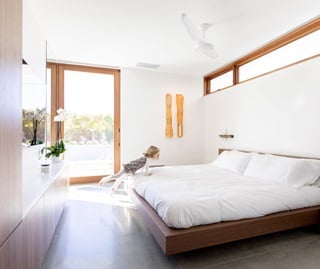Yes. Windows for new construction are designed to be installed during the construction process, usually prior to siding installation. Most have flanges that are fastened to the window framing. Replacement windows are sized to be fastened into an existing window opening without needing to remove any siding.
How-To
Top 7 Questions to ask when Buying Windows
Windows are both simple and extremely complex. Their basic function has not changed since the pioneer days when greased paper was used to cover holes in the walls and allow light indoors. Thankfully, modern technology has led to great improvement in window design and function, which has resulted in an array of window options, as well as some new questions. Learning answers to those questions will ease the work of maintaining windows or the process of shopping for new ones.
Fiberglass
Fiberglass is a manmade material, so you will find a wide variety of quality and performance standards. Marvin offers two types of fiberglass that both provide great insulation and have the advantage of dimensional stability that is very similar to window glass, so the glass and the fiberglass frame expand and shrink at similar rates. This makes for premium durability. Avoid fiberglass with high concentrations of plastics and vinyls, or with sawdust and wood fillers. Premium fiberglass used in window construction is made simply with fiberglass fibers and resins that have high strength and do not sag or become brittle in extreme heat or cold. Some windows combine the weather-resistance of fiberglass or fiberglass cladding on the exterior with wood interiors that respond better to stain or paint.
Aluminum
Aluminum is commonly used on the exterior of a window, generally to clad a wood window. It is very resistant to impact and extreme weather and thus is used extensively in areas prone to high winds and tropical storms. Marvin Coastline windows and doors, for example, are completely made of extruded aluminum for strength to withstand hurricane winds. Aluminum is low-maintenance and resistant to color fading and degradation. Look for aluminum cladding that is extruded into finished profiles in the manufacturing process. Extruded aluminum is thicker than roll-form aluminum and performs better.
Vinyl
Vinyl Windows made from vinyl (usually PVC) are less costly, low-maintenance, and if the frames are not hollow, they are decent insulators. Because dark exteriors can soften or sag from heat or direct sunlight, most vinyl windows are white or buff, so the color selection is limited. They can also become brittle in very cold temperatures.
Related Articles

10 Things to Ask to Find a Window & Door Contractor or Dealer
Protect your investment and your home by making an educated choice on a window dealer and contractor for your replacement project.

Types of Wood for Doors & Windows: Oak vs. Pine vs. Mahogany
A lifelong wood expert reveals what you should know about wood for windows and doors.

A Homeowner's Guide to Understanding Glass Performance and Types
You don’t need to completely understand the technology, but you should know that you have options.

Learn More About Marvin Collections
Whether you desire design inspiration or are searching for more information, Marvin offers a wide array of brochures and catalogs to help you with your next project.

